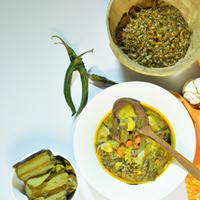
1 serving (200 grams) contains 150 calories, 10.0 grams of protein, 3.0 grams of fat, and 25.0 grams of carbohydrates.

Log this food in SnapCalorie

Nutrition Information
Calories |
176.5 | ||
|---|---|---|---|
% Daily Value* |
|||
| Total Fat | 3.5 g | 4% | |
| Saturated Fat | 0.6 g | 3% | |
| Polyunsaturated Fat | 0 g | ||
| Cholesterol | 0 mg | 0% | |
| Sodium | 470.6 mg | 20% | |
| Total Carbohydrates | 29.4 g | 10% | |
| Dietary Fiber | 9.4 g | 33% | |
| Sugars | 2.4 g | ||
| protein | 11.8 g | 23% | |
| Vitamin D | 0 mcg | 0% | |
| Calcium | 94.1 mg | 7% | |
| Iron | 3.5 mg | 19% | |
| Potassium | 588.2 mg | 12% | |
* Percent Daily Values are based on a 2,000 calorie diet. Your daily values may be higher or lower depending on your calorie needs.
Food Attributes
Source of Calories
About Monggo with ampalaya
Monggo with Ampalaya is a hearty Filipino dish combining mung beans (monggo) and bitter melon (ampalaya), often enjoyed as a nutritious main or side dish. This flavorful stew typically includes garlic, onions, and tomatoes sautéed in oil, with the addition of nutrient-rich ampalaya and sometimes spinach or moringa leaves for a boost of greens. Protein options such as shrimp, pork, or small amounts of fish sauce may be included. Originating in Filipino home kitchens, it reflects a blend of simplicity and health-conscious cooking. Packed with fiber, plant-based protein, vitamins A and C, and iron, it promotes good digestion and supports immunity. However, those watching salt intake should be mindful of added seasoning or fish sauce. Despite the bitter taste of ampalaya, this dish is a wholesome choice for anyone seeking a nutrient-dense meal rooted in Filipino traditions.



